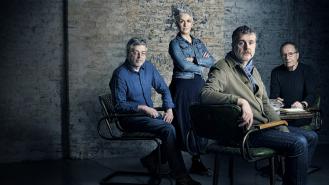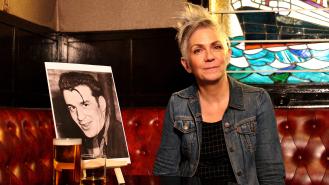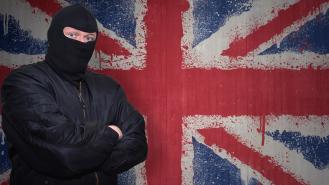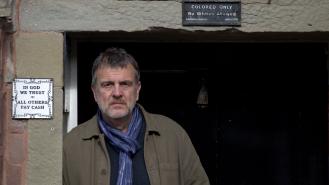
'This was mass murder of an innocent family': The Ice Cream War Murders
Four of Britain’s best-known crime writers turn detective in a brand-new series Once Upon a True Crime, exclusive to Crime+Investigation. Featuring Peter James, Denise Mina, Mark Billingham, and Douglas Skelton, the show investigates the real-life murders that inspired some of the acclaimed authors’ most famous novels.
In the final episode, Douglas Skelton shares his inside knowledge of the notorious Ice Cream War Murders which inspired his novel Blood City. This tense gangland turf war led to a devastating arson attack on the home of an innocent family swept up in the events.
Skelton revisits the gritty scenes of Glasgow’s East End in the 1980s, where rival organisations were locked in a campaign of violence and intimidation as they competed to sell goods (including stolen items) from their ice cream vans.
Crime+Investigation spoke to Douglas about the episode and found out why he thinks justice will never be fully served.
What was Glasgow like in the '80s?
Glasgow gets a bad reputation and some of it is merited and some of it is not but certainly, in the 80s, there were a lot of problems and cities up and down the UK.
You had a city that was once known as 'the second city of the Empire' and things were changing. The heavy industry had already died and so the city itself was enjoying a rebirth in many ways in certain areas in the latter part of the 80s and into the 90s.
In the early 80s, you had the schemes [housing estates]. The ones that we're focusing on in the programme and in connection to this particularly horrendous case, were in the East End of the city. They were designed to get the people out of the overcrowded city streets and into brand new housing.
Can you explain the importance of ice cream vans to these communities?
The ice cream vans were important because they were not just selling ice cream, some of them were mobile shops and they were providing a vital service to streets that perhaps didn't have easy access to shops.
The planners forgot to include basic amenities like shops in some of these schemes. So, the ice cream vans provided a service. They had ice creams, but they also had cigarettes and they had sweets. They had what we call in Glasgow 'ginger', which are soft drinks and some of them even sold some food. So that's why they became quite important to residents of the scheme.
How did criminal elements become involved with ice cream vans?
One thing we know about the criminal element is if they see a way to make your money, they're going to move in. I think it's unfair to paint the entire ice cream van industry as being infiltrated by criminals because it certainly wasn't. There were certain elements on certain runs across the city who saw a way of perhaps making some money legitimately, but also perhaps of laundering ill-gotten gains through this kind of business. They were in the habit of trading in stolen goods. They could sell those stolen goods off the back of the van.
There is an urban legend that it was to do with drugs, and I have found no evidence whatsoever over the years that sort of endeavour took place. I'm not saying it didn't happen, but it wasn't organised crime.
Why were the Doyle Family targeted?
What happened to them ultimately, was utterly horrendous and unforgivable. Andrew Doyle was hired as a driver and was brought in by another man who had two or three vans already running in the scheme.
The Doyle family were a decent family. There is no suggestion that they were involved in any kind of underhand practices, or any sort of criminality and we need to make that perfectly plain.
Was the arson attack meant as a 'frightener' that spiralled out of control?
Who knows what the thinking was? We're not sure why they set fire to the Doyle's front door, but the idea would be to send a message though they took it further. They poured the petrol as far as I'm aware through the letterbox, under the door and into the cupboard beside the door, which was like a storeroom where there was some old timber and paint pots and a candlewick bedspread.
They were obviously complete and utter idiots for what they did, and they caused what can only be described as a tragedy through their thoughtlessness.
You first encountered this case as a journalist, what made it stand out for you?
It was the biggest mass murder in Scottish Liberal history until Lockerbie. Questions were hanging over and both Thomas Campbell and his co-accused Joe Steele who had consistently proclaimed their innocence.
When Lisa Brownlie and I set out to write the book [Frightener: The Glasgow Ice-cream Wars], we weren't convinced of anybody's innocence. We thought they were guilty. We thought Justice had been done.
Slowly but surely as the research went on, and as we spoke to people, we realised that there were questions here that had to be asked.
In your episode, it seems the police overlooked basic leads to focus their attention on the two men. What explains this approach?
Who knows? The only thing I can see is that they had to what I call prime suspect syndrome. When Thomas Campbell who was a known criminal came into the frame, they decided that it was him.
They set out to prove that it was him and find the evidence that linked him to it. This is just my opinion as I wasn't there, but this blinkered attitude continued throughout the investigation.
Thomas Campbell and Joe Steele fought very hard to prove their innocence from within jail. How did they raise awareness of their plight?
Thomas Campbell staged what we call hunger strikes. He just called them protests. Joe Steele did change a lot of public perception. He became what we call the 'Papillon of the Scottish prison system'.
He escaped three or four times. Another time he was foiled only because as he was heading to the jail's gate wearing a prison officer's white coat with a master key in his pocket somebody looked up and said, 'That looks like Joe Steele'. So, he was stopped from getting out on that final occasion. His escapes went a long way to change public perception about the case because several people said to me: 'Well, I was undecided or I believed they were guilty but then he escaped and handed himself back and I thought why he would do that, he could have been away?'
Thomas Campbell's hunger strikes also played the part because people said: 'Why would that man put themselves through that and almost die? If he wasn't if there wasn't some truth in what he's saying?'
I think towards the end of the episode, you say this is a stain of Scottish justice. Do you think that stain will ever be expunged?
No. I don't think there's the appetite to have any kind of investigation and I think the time has passed anyway. I believe it should have been called when the men were cleared to look at this case to find out what exactly went wrong. This was not just a shoplifting case or a minor assault. This was mass murder of an innocent family.
In your work as a crime author, you have set books in Glasgow and the Highlands. Why do you think Scotland is such a good location for crime fiction?
It would appear to be a good place because there's an entire industry growing up and I started writing books in the early 90s. there was Ian Rankin and Val McDermid writing books. Before that there had been crime fiction set in Scotland, but not the vast explosion that we've had since. And frankly, there are far too many, I think we need to get rid of a few! But I'm working on that...
There's something about Scotland because of its duality. Just within half an hour's drive from any Scottish city, you can be out in a wilderness of such beauty that it takes your breath away. All that adds into crime fiction. Plus, there's also the dark Celtic soul that comes into it as well.
Once Upon A True Crime is available to stream on Crime+Investigation.











